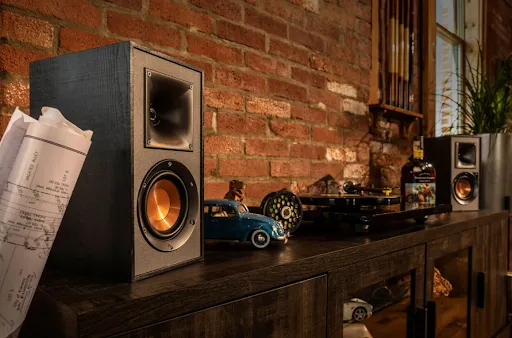Have you ever imagined what life would be like if we had background music as they do in films and TV shows? It would certainly make things more interesting and comfortable. After all, music is said to lessen stress and pain, offering the perfect distraction. It can also help us be more in tune with ourselves, as it’s a medium to express our deepest feelings and emotions and relive some cherished memories.
One way to enjoy real-life background music is by setting up your own hi-fi system at home. The quality of sound this kind of system can reproduce is enough to understand what the fuss of audiophiles is all about. Don’t be surprised if the addition of hi-fi equipment turns you into an audiophile yourself!
This system consists of various parts, from the source and amplifier to the specific Hi-Fi cable. But it’s the speakers that steal all the spotlight. And with reason! You may nail it by investing in all the high-end source, amplifier and cable components, but fail if you don’t pay the speakers the required attention and all you hear is background noise instead of genuine sound with studio-level quality.
What Makes a Good Hi-Fi Speaker?
In simple terms, it’s the one that can reproduce the sound accurately the way the artists intended it to be heard, which is where the magic lies. If you’re an avid music fan, you’ve probably already had your fair share of speakers and know some are better than others. So, how to be aware of which is which when shopping for the ideal set of wireless hifi speakers for your audio system?
One piece of advice would be to consider what the best of the best brands are offering. After all, there’s a reason why they’re among the best, and some aspects that made them reach those levels are frequency response (i.e. the range of frequencies it can produce), fewer variations in the output (i.e. the variation in loudness between frequencies), choice of materials, and the beauty of the design itself.
Some quality build materials that truly make a difference in the audio quality are aluminium, Kevlar and beryllium. While they’re light and don’t add to the weight of the wireless hi-fi speakers, they’re still sturdy and durable enough.
Flexing isn’t a desired quality, as it can lead to sound distortion. That’s why some of the best models are made of rigid materials, as they don’t result in sound distortions even when playing music at high frequencies. As for the design, quality stands out by being aesthetic as much as it is functional, so you’d make the most of a purchase that’s equally decorative as it is practical.
What to Look for When Buying?
Although sound quality is a personal decision, based on the loudness and type of music you mainly listen to, as are the design and colour, there are still some factors to keep in mind when shopping for HiFi wifi speakers for your system. Factors such as:
The Price
You’d be surprised to see just how inclusive price ranges can be. Some can be relatively cheap, up to $100, others are in between up to $500, and of course, there are those premium choices that go up to $1000, $2000 and above.
It’s important to know how much you’re willing to spend to get an idea of the total price for a full HiFi sound system setup, as there’s more than the wireless stereo speakers to take care of if you want to make the most of quality sound.
On the lower end, you may not get anything too impressive with the soundscape, though you’d still get the basics which is great if you’re just starting out as an audiophile. In terms of watts, some can go as up as 30+ whereas others even solid 100 which can still be plenty. With most manufacturers, for these price ranges, you can get compact bookshelf models perfect for smaller rooms.
Now, in the mid-range, some can offer you a single floor-standing model, while others might even get you a multi-speaker setup, so it all comes down to the brand. And lastly, on the pricier end, you do get more in terms of wattage (from 100 to more than 200) and aesthetics with a seamless high-end finish. You can find both premium floor models as much as bookshelf designs here.

The Type
Much like the wired type, you can find wireless hi-fi speakers in various designs, from the floor-standing and the bookshelf to the subwoofer, soundbar and portable. Each can serve as a simple single stereo setup or multi-channel surround sound. It all comes down to how much you’re willing to spend and how much space you’ve got for this audio addition to your home.
The floor-standing type is impressive, with outstanding resonance dampening and overall better sound quality, and can even serve as a focal décor feature in a living room, for example, but it does take up considerable floor space, unlike the bookshelf design or any of the three others that I mentioned. Be sure to consider your layout and the area designated for the speakers while shopping.
Another distinction is between the passive and active types. Passive types are those that rely on an amplifier for the production of sound, whereas active speakers are those that do the production themselves thanks to an in-built amplifier. Despite the fact you can create a more affordable setup with active models, truth be told, they aren’t that suited for upgrades like the passive, so there are these pros and cons you need to have in mind when purchasing.
The Compatibility
This refers to the matching of the passive speakers with the amplifier. It’s also a crucial factor that isn’t to be brushed off because you won’t want to find out the hard way that the impedance and power of the speakers are incompatible with those of your chosen amplifier.
Impedance is measured in ohms and refers to the electrical resistance of these two hi-fi system components. You don’t have to match the ohms of the speakers with those of the amplifiers, as even a higher impedance design (i.e. more ohms) would do when paired with a lower impedance amplifier (i.e. lesser ohms).
Remember, though, vice versa won’t work! When it comes to power measured in watts, it indicates how much the speaker can handle and how much the amplifier can produce. Keep an eye on the manufacturer’s recommendations on amplification with that of amplifier power output to be sure you make the right decision.

The Placement
To get the best option for your setup, you first need to plan out where you’re going to place them. Besides considering space and matching it with that of the suitable model, it’s necessary to also think of the room’s acoustics.
The presence of floor coverings and decorative textures like cushions and curtains can provide better acoustics as they absorb the sound, while bare floors and a lack of such textures can affect the quality. Consider this, along with the speakers’ sensitivity indicated in decibels, to get an idea of how much volume you can expect.





